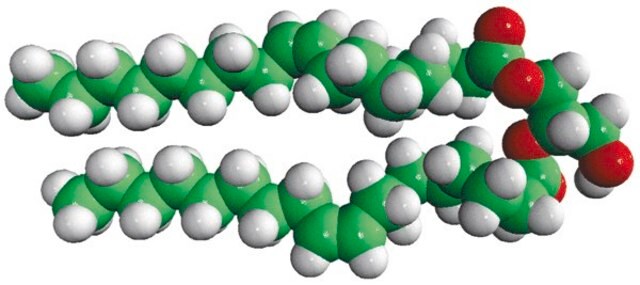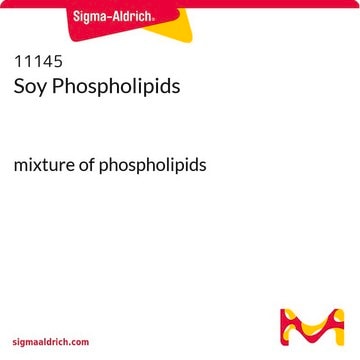800819C
Avanti
18:0-22:6 DG
1-stearoyl-2-docosahexaenoyl-sn-glycerol, chloroform
Sinônimo(s):
1-octadecanoyl-2-(4Z,7Z,10Z,13Z,16Z,19Z-docosahexaenoyl)-sn-glycerol; DG(18:0/22:6(4Z,7Z,10Z,13Z,16Z,19Z)/0:0)
About This Item
Produtos recomendados
Ensaio
>99% (TLC)
Formulário
liquid
embalagem
pkg of 1 × 5 mL (800819C-10mg)
fabricante/nome comercial
Avanti Research™ - A Croda Brand 800819C
concentração
2 mg/mL (800819C-10mg)
tipo de lipídio
neutral lipids
neutral glycerides
Condições de expedição
dry ice
temperatura de armazenamento
−20°C
Descrição geral
Diacylglycerol mimicks the effects of the tumor-promoting compounds phorbol esters.
Aplicação
- in the preparation of Golgi-like liposomes
- to study its effect on conventional protein kinase C (cPKC) and novel protein kinase C (nPKC) isozymes in vitro
- as a substrate for the measurement of diacylglycerol kinase η1 (DGKη1) activity in vitro
Embalagem
Armazenamento e estabilidade
Outras notas
Dry samples of diacylglycerol in chloroform, using a stream of nitrogen. Dissolve the residue in an appropriate volume of ethanol or DMSO, then dilute to the desired aqueous medium.
Most biological responses saturate at 20 to 250 μM sn-1,2-dioctanoylglycerol. Only sn-1,2 isomers appear to be active.
Informações legais
Palavra indicadora
Danger
Frases de perigo
Declarações de precaução
Classificações de perigo
Acute Tox. 3 Inhalation - Acute Tox. 4 Oral - Aquatic Chronic 3 - Carc. 2 - Eye Irrit. 2 - Repr. 2 - Skin Irrit. 2 - STOT RE 1 - STOT SE 3
Órgãos-alvo
Central nervous system, Liver,Kidney
Classe de risco de água (WGK)
WGK 3
Escolha uma das versões mais recentes:
Certificados de análise (COA)
It looks like we've run into a problem, but you can still download Certificates of Analysis from our Documentos section.
Se precisar de ajuda, entre em contato Atendimento ao cliente
Já possui este produto?
Encontre a documentação dos produtos que você adquiriu recentemente na biblioteca de documentos.
Nossa equipe de cientistas tem experiência em todas as áreas de pesquisa, incluindo Life Sciences, ciência de materiais, síntese química, cromatografia, química analítica e muitas outras.
Entre em contato com a assistência técnica










